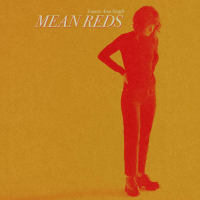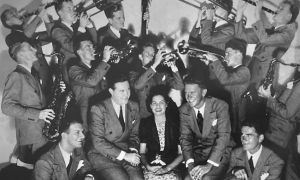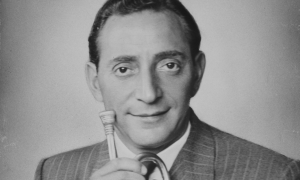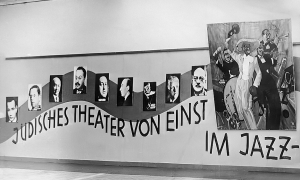Home » Jazz Articles » History of Jazz » Vince Guaraldi’s Christmas Sauce: Adding Spice to Charli...
Vince Guaraldi’s Christmas Sauce: Adding Spice to Charlie Brown Vanilla

Courtesy Charlotte Jazz Room
Children liked the music because they didn't question it.
—Vince Guaraldi
Like Santa arriving undetected down the chimney without raising any alarms, A Charlie Brown Christmas is said to have gifted jazz upon more new listeners than even Miles Davis' benchmark Kind of Blue (Columbia, 1959). Guaraldi historian Derrick Bang believes misperception of the music as bland, easy-listening conceals Guaraldi's innovations, taken for granted through its saturation and accessibility. Unwrapped, the music reveals abundant complexity underlying surface simplicity. Starting often with bass ostinatos from boogie woogie, Guaraldi inserted Afro-Cuban rhythms of mambo and montuno phrasings, Brazilian, bossa nova, blues, swing, bebop, and boogaloo.
In May 1965, the same year as the Charlie Brown special was first broadcast, Guaraldi was four months ahead of Duke Ellington's First Sacred Concert with an Episcopal Jazz Mass in San Francisco's Grace Cathedral. Guaraldi did not hold himself out be a great pianist, but he was knowledgeable and adept about his instrument. He used open voicings, by which notes of chords spread over a range wider than one octave, creating a richer, more "open" sound. He was physically short, with small hands, and accomplished with finger movement what he could not otherwise stretch to cover. When playing a solo, Guaraldi used his left hand sparsely, without complex harmonies, using single notes in the right hand. Rhythm switches from straight eighth notes to swing, with highly-melodic variations on the theme. His intervals of notes within chords of fourths, fifths, and major thirds sounded childlike, but Guaraldi intended the effects he created.
He gently pushed rhythms with slight pauses between notes to complement melodic leaps. He frequently used a "double stop" on the keyboard in which two notes are played at once, the top note is held or repeated, and the bottom note changes. For Guaraldi, it's sliding the bottom note up the keyboard to create minor thirds, a blues device. He used enclosures, by which a tone within a chord precedes and follows the chord itself, frequent in bebop. Basslines of tritone walkdowns descend between chords sharing a common tone. Jean Schulz, the widow of Peanuts cartoonist Charles M. Schulz, said that Guaraldi captured in his music the way children "walk and bounce a little bit," just as in the animations. Children liked the music, Guaraldi said, because they didn't question it.
Flexibility Beyond Christmas
Guaraldi composed for sixteen Peanuts programs, and applied his music freely across varied themes within that series. Unlike the sounds of "Jingle Bells" or "Sleigh Ride," which convey dashing through the snow even without lyrics, there is nothing inherently "Christmas-y" about "Linus and Lucy" or "Skating" from A Charlie Brown Christmas until made indelible with the holidays by words and images. The left hand bass notes at the beginning of "Lucy and Linus" are boogie woogie, followed by swing. A similar bass line pulses energy into "Skating," before the cascading notes of the melody. His most famous pre-Peanuts composition, "Cast Your Fate to the Wind," also begins with a repeated bass line, before the melody is introduced, and traces can be identified in "Linus and Lucy."Different arrangements of "Linus and Lucy" can be heard in the familiar Charlie Brown Christmas; an earlier effort, Jazz Impressions of A Boy Named Charlie Brown; orchestrated for A Charlie Brown Thanksgiving; and at faster tempo on a later presentation, Oh Good Grief. In the animated film A Boy Named Charlie Brown, the same driving left-hand and a more urgent pace establishes a "Mission Impossible" spy theme as Linus searches for his lost blanket in New York City. Brad Mehldau's solo rendition of "Monk's Dream" from his Live in Tokyo (Nonesuch, 2004) unexpectedly twice quotes from "Linus and Lucy," at the 3:00 minute mark and again shortly thereafter. Wynton Marsalis' interpretation of "Linus and Lucy," on his tribute album Joe Cool's Blues (Columbia, 1995), replaces the bass chords with percussive New Orleans horns.
A dissertation by Alec Huntley of the University of North Texas found rhythms and harmonies of Afro-Cuban music everywhere in Guaraldi. Peanuts compositions, like most of Guaraldi's other material, often followed standard jazz "head" form: statement of a prevailing theme, followed by improvisation over a repeating chord progression sandwiched between interpretations of a composed melody. But Huntley observed that many of Guaraldi's compositions use a form more common to Afro-Cuban music than to jazz or even bossa nova. "Although they begin and end with a statement of the head, the middle section over which Guaraldi improvises repeats a short chord progression like those found in mambo sections. The middle portion of 'Christmas Is Coming,' for example, is a repeating progression that contrasts with the head that precedes and follows it."
The Holiday Whirl
Concert and stage performances continue beyond the recordings. David Benoit, music director for a later series of Peanuts specials, has a 15-city "Christmas Tribute to Charlie Brown" tour through December. "A Charlie Brown Christmas: Live on Stage" utilizes a jazz trio, just as in the original, and live performers in two touring companies for 39 dates, starting in Illinois the weekend before Thanksgiving, returning to the New York State area, roaming the Midwest and as far south as Tennessee, visiting some cities that rarely see live musical theater, before returning for four nights December 21-25 at the Palladium Times Square in Manhattan.Four different venues in Seattle have each done full presentations in the same years. December 12 of this year, the Jose J. Gonzales Trio plays the Cornish Playhouse at Seattle Center for the tenth year, in matinee and evening presentations to benefit the community Strawberry Theater. The San Francisco Jazz Center, SFJAZZ, features pianist Adam Shulman on December 17 and 18. Other communities draw upon local musicians for their best holiday efforts.
This season retailers from Barnes & Noble to Walmart and Urban Outfitters offer individualized specialty pressings of the Christmas album on a potpourri of vinyl from Craft Recordings: red, green, translucent, red and green splattered, peppermint and metallic gold and green swirls, snowflake, glitter-infused clear, picture embossed, silver-foil wrapped, and, for the formal: standard black. Not to miss out, this publication offers a holiday edition raffle: Enter the giveaway.
The Library of Congress recognizes the Christmas album as "culturally, historically, or aesthetically important." It has sold in the millions, with numerous repackaged iterations, promotional tie-ins, reissues, and remixes. Some devotees obsess over slight variations, fadeouts replaced with more complete versions, synthesis of different takes, discrepancies in liner notes and sidemen credits, retrieved histories, recovered samples, and collectible editions.
Acquiring Knowledge
Guaraldi was born in 1928 in San Francisco's Italian North Beach, the hilly streets overlooking the bay, above Broadway and the old Barbary Coast district that came to house jazz nightclubs. The city had always been a port town, with music and cultural imports from around the world. Jelly Roll Morton, a founding father of jazz, opened his Jupiter Club there in 1917 with his "Spanish tinge" shadings beyond ragtime from New Orleans. Guaraldi came of age when boogie-woogie was popular; it formed his early playing experience in teenage dance bands, and those characteristic left-hand lines remained with him.He took piano lessons while in high school, graduating in 1946, and rather quickly thereafter stepped onto professional bandstands. By summer three years after graduation he was with former Thelonious Monk saxophonist Kermit Scott, playing Yosemite National Park. Next was seasoning among the five dozen clubs that once dotted San Francisco in the years after World War II. In 1950 he began jamming with vibraphonist Cal Tjader, and formally joined Tjader the next year. His continuing education came in encounters with a series of greats: Benny Goodman, Stan Getz, Ben Webster, Coleman Hawkins, Sonny Stitt, and a year on the road with Woody Herman's Third Herd big band. Dedicated to his own improvement, he sequestered himself away for a year of isolated practice before joining Herman.
Tjader had caught wind of a developing mid-century craze for samba and bossa nova, pursued those as styles, and learned on the job through Latin musicians and stylists brought into his band for authenticity. He ventured to Spanish Harlem in New York to listen and learn at live performances of timbales master Tito Puente and bandleader Francisco "Machito" Grillo. Stan Getz paired with Tjader and Guaraldi in 1958 recording a lengthy, energetic samba and other tunes six years before the saxophonist's breakout "Girl From Ipanema." Billy Higgins, later the most recorded drummer for Blue Note Records, and Scott LaFaro, later the preferred bassist of Bill Evans, were with them.
Joining Tjader more formally was bassist Al McKibbon, who had been with Dizzy Gillespie's band in the late 1940s experimenting with a fusion of jazz and Afro-Cuban music, and was bassist for Miles Davis on the 1949/1950 sessions for Birth of the Cool (Capitol, 1957). Victor Feldman, later the pianist for Davis' Seven Steps to Heaven (Columbia, 1963), and much later for Steely Dan, recorded Latinsville! (Contemporary) in 1959 with percussionists Mongo Santamaria and Willie Bobo from Tito Puente's orchestra. Santamaria and Bobo also joined Tjader, and his pianist Guaraldi, in San Francisco.
Guaraldi's immersion in all this, combined with more standard jazz language, during a decade as apprentice and journeyman, became distilled in his fingertips. Larry Vuckovich, now in his mid-80s and the senior active pianist in Northern California jazz, was once Guaraldi's only student and continues with retrospectives of his teacher. Vuckovich will be at Yoshi's jazz club in Oakland, CA on December 23, with his own wide repertoire, inclusive of Guaraldi. Much of their instructional time together was in listening to others, classic performers such as Oscar Peterson and Bill Evans, and then Guaraldi demonstrating phrases for Vuckovich to repeat. He believes that Guaraldi acquired the Latin and Brazilian feel from similar close study as well.
Vuckovich says the mid-century music should be heard not only as an artifact of its era, but with appreciation for the imagination in its creation. "It was fresh at the time," he instructs. "Music is never dated when it comes from the heart." Vuckovich points to "Viva Cepeda" from 1958 by Tjader and Guaraldi, an enthusiastic dedication to a past San Francisco Giants first baseman, Orlando Cepeda, as a piece that would be current today. Guaraldi recorded "Autumn Leaves" independent of Tjader that same year. There are two versions easily available: one shorter and delicate, the other takes more time to tell its story in a ten-minute rendition with deeply-felt solos by Guaraldi and bassist Monty Budwig. That longer version is on the Fantasy/Concord 2-CD compilation The Definitive Vince Guaraldi along with 30 other songs presenting a good survey of his career.
At his best, Guaraldi plays with grace, and joy. Within and outside of the Peanuts canon, Guaraldi can move from slow contemplation or jazz waltz at the head, then swing through middle sections, and/or pepper with those Latinisms. Vuckovich says it reveals the underlying musical knowledge that supported the work, lacking today in players who rush toward whatever is new but lack historical foundations. "You must have knowledge!," he exclaims.
The Winds of Chance
Guaraldi continued his explorations in partnership with Brazilian guitarist Bola Sete. That would lead to Guaraldi's 1962 album, Jazz Impressions of Black Orpheus (Fantasy), covers of songs from a film set in Brazil's carnival celebration, with one additional original to fill out the album: "Cast Your Fate to the Wind." Guaraldi's further ascendance occurred from chance, as if directed by his own good advice in the song's title."Cast Your Fate" has a breezy existential openness, a thoughtful and improvisational middle, and hopeful send-off. It had been consigned to the B-side of a single promoting another number from Black Orpheus, and issued at all only due to Guaraldi's strong insistence. Enterprising disc jockeys in Sacramento uncovered it and gave it airplay. The Grace Cathedral Jazz Mass was commissioned after a clergyman heard the song on the radio and sought out its composer to make the ecclesiastical more contemporary. Film producer Lee Mendelson heard the song while driving across the Golden Gate Bridge; he recalled it as melodic and open, like a breeze off the bay, and contacted Guaraldi to score a documentary on cartoonist Schulz.
That project did not find commercial support, although its music was released as the soundtrack for a CBS special that never was, A Boy Named Charlie Brown; that same title was used several years later for a different animated film for theater release. The music also saw life packaged as a Guaraldi studio album, Jazz Impressions of A Boy Named Charlie Brown (Fantasy, 1964). Some of that music, including "Linus and Lucy," was recycled into A Charlie Brown Christmas when Mendelson created that project. Executives at CBS television hated the special in a preview: too slowly-paced, the suits thought; the animation and music both strange to them. Only because TV schedules had already been printed, and Coca-Cola signed on as a sponsor, did the show proceed. The result was a smashing success: almost half the viewing televisions in America were tuned in, and additional Peanuts specials were immediately ordered.
Guaraldi devoted much of his efforts to subsequent Peanuts animations, with limited other recording. Even after his Peanuts successes, he chose to remain mostly on the West Coast, living in the San Francisco Bay Area, content to play smaller auditoriums and club dates. Arrangements of his tunes were made by John Scott Trotter, orchestrator for Bing Crosby's "White Christmas," with Charlie Brown Christmas atop the great Christmas classics, connecting across generations. Guaraldi's career ended prematurely, of a heart attack at age 47 in 1976, ending what more he might have delivered, although Peanuts and Charlie Brown projects have continued under others.
What It's About
Guaraldi did not write out extensive scores; he started with a head sheet notations and then improvised, "completing" a number by woodshedding it with this bandmates, but leaving it open for finishing touches and variations in the moment. That process was initially disconcerting to the highly-trained youth choir used for "Christmas Time Is Here," until they were encouraged in spontaneity. Being slightly off key in the moment was found charming.Transcriptions of his most played songs are contained in Hal Leonard's The Definitive Vince Guaraldi and The Vince Guaraldi Collection, along with other volumes of many arrangements of the Christmas pieces. His Jazz Mass was not transcribed until 50 years after its performance, and only then by a Presbyterian pastor and bebop pianist outside of Scranton, Pennsylvania, Bill Carter, who was looking to freshen his own services.
The last surviving members of Guaraldi's trios passed away in 2021, both drummers: Colin Bailey, and Jerry Granelli. Bailey had played on "Cast Your Fate to the Wind," and an early "Linus and Lucy" from Jazz Impressions of A Boy Named Charlie Brown. Granelli had been on sessions that became A Charlie Brown Christmas. Granelli had spent decades avoiding the music, seeking not to be defined by it and was aggravated over old royalty disputes. He returned to it, however, embracing the reasons he saw for its durability: "It's about family, it's about love. It's about caring for each other."
He recalled the experience of the recording sessions. "We knew the feeling of Charlie Brown; we knew the feeling of Charlie Schulz. We had a relationship with Charlie and his wife and family. Charlie Brown is pathetic, sarcastic, wise, and playful, all at the same time, very much like Vince Guaraldi. We were just trying to catch the feeling of it. Vince had these tunes—some of which had been written for other things—and he pulled one or two out. He'd bring another in, and we'd rehearse it, play it out on a gig, and then we just went in and did it. It was really simple. And honest. Vince always demanded we played our hearts out. We played our best." *
* From a 2017 Aquarium Drunkard interview by Jason P. Woodbury.
Tags
History of Jazz
Vince Guaraldi
Arthur R George
United States
California
san francisco
Miles Davis
duke ellington
brad mehldau
wynton marsalis
David Benoit
Jose J. Gonzales
Seattle
San Francisco Jazz Center
Adam Shulman
Jelly Roll Morton
New Orleans
Thelonious Monk
Cal Tjader
Benny Goodman
Stan Getz
ben webster
Coleman Hawkins
Sonny Stitt
Woody Herman
Tito Puente
Machito
Billy Higgins
Scott LeFaro
Bill Evans
Al McKibbon
Dizzy Gillespie
Victor Feldman
steely dan
Mongo Santamaria
Willie Bobo
Larry Vuckovich
Yoshi's
Oakland
oscar peterson
Monty Budwig
Bola Sete
Sacramento
Bing Crosby
Colin Bailey
Jerry Granelli.
PREVIOUS / NEXT
Support All About Jazz
 All About Jazz has been a pillar of jazz since 1995, championing it as an art form and, more importantly, supporting the musicians who make it. Our enduring commitment has made "AAJ" one of the most culturally important websites of its kind, read by hundreds of thousands of fans, musicians and industry figures every month.
All About Jazz has been a pillar of jazz since 1995, championing it as an art form and, more importantly, supporting the musicians who make it. Our enduring commitment has made "AAJ" one of the most culturally important websites of its kind, read by hundreds of thousands of fans, musicians and industry figures every month.






















